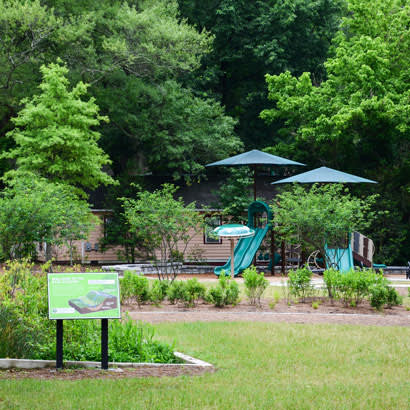
In a 2010 article in the Boston College Environmental Affairs Law Review, environmental lawyer and current Environmental Protection Agency Regional Administrator for Region 1 (New England) Alexandra Dapolita Dunn listed the “exceptional benefits for the urban poor” that green infrastructure (including parks) can provide as better air and water quality, improved public health, enhanced aesthetics and safety, green job opportunities, increased food security and more. Recent research by NRPA and George Mason University highlights the important role that parks also play as economic infrastructure by attracting businesses, residents and visitors to a community. There is a concern, however, that park investments can lead to displacement of existing residents by attracting new, wealthier residents and increasing property values, a process called gentrification.
The evidence shows that residents of low-income and minority communities have less access than their more affluent neighbors to parks and other forms of green infrastructure. In a 2016 survey of 49 studies on this issue, Alessandro Rigolon, an assistant professor at the University of Illinois at Urbana-Champaign, found that ethnic minorities and low-income people have slightly better access to parks in terms of proximity (walking distance), but striking inequities exist in terms of park acreage, quality, maintenance and safety. A study in Oakland, California, found that tree-canopy coverage ranged from 47 percent in a high-income council district to 12 percent in a low-income council district.
Research also shows that investment in parks can lead to substantially increased property values and housing prices. Between 2003 and 2011, property values near the High Line in New York City increased 103 percent, despite the deep recession, and $2 billion had been invested in related development. Housing prices along a portion of the 606 Trail in Chicago rose 48 percent from 2013 (when construction began) to 2016.
‘Just Green Enough’
New York City’s High Line and Chicago’s 606 Trail are examples of signature park investments, designed as regional attractions that draw visitors from well beyond their adjacent neighborhoods. What, then, can be done to improve social equity and prevent gentrification through local park investments? Based on field work in the Greenpoint area of Brooklyn, New York, researchers Winifred Curran and Trina Curran coined the term “just green enough” to describe a strategy, led by the local community, to achieve environmental remediation without gentrification. This strategy targeted clean-up of a severely contaminated creek in a working-class neighborhood and development of local-serving greenspace along the creek while maintaining industrial uses and jobs.
Regardless of terminology (and I’d suggest “community-driven green” as an alternative to “just green enough”), an approach to achieving social equity through local parks should begin with the premise that low-income and minority residents have as much equal right to access quality parks and green spaces as more advantaged populations — perhaps even more so, given the legacy of underinvestment and environmental injustice that’s all too common in their neighborhoods. The approach includes three key principles:
- First, residents must be engaged in a robust, community-driven process to identify local priorities and needs for parks and green spaces.
- Second, the resulting investment should leverage the environmental, economic and social co-benefits parks can provide in meeting community priorities. These might include improving environmental conditions, creating local jobs and providing a place for community gathering and recreation.
- Third, the park investment should be coordinated with planning strategies to address broader community needs, such as housing, economic development and transportation. The latter is particularly important to address the potential for gentrification through actions to preserve and expand affordable housing stock, relieve pressures on low-income tenants and homeowners, and increase economic opportunity for residents.
Park investments following this model are smaller in scale than civic green space projects, like the High Line and 606 Trail, and may occur on scattered sites and/or in diverse forms, such as neighborhood parks, community gardens, greening of vacant lots and green alleys.
Lindsay Street Park in Atlanta is an example of a small (1.5 acre) park that had a big impact on the surrounding community. Opened in 2015, it was the first park in the English Avenue neighborhood, which has a history of crime, vacancy, and unemployment. The park was developed through a grassroots partnership involving The Conservation Fund, Park Pride, the city of Atlanta and others, with the process of identifying improvements led by residents. The project uses green stormwater infrastructure to reduce flooding and improve water quality. Co-benefits include reclamation of vacant lots once filled with weeds and trash, training and jobs for local youths, and providing a safe place for kids to play and the community to gather.
Is Gentrification Inevitable?
As research director for the American Planning Association (APA), I was privileged to partner with NRPA on the Great Urban Parks Campaign, an initiative to explore the benefits that green stormwater infrastructure in parks can bring to underserved communities. APA’s role included preparing a series of briefing papers (available through the NRPA and APA websites) to help public officials, planners and park professionals make decisions and formulate local policies around parks and green infrastructure. These briefing papers provide more information on the connections between parks, equity and green infrastructure, including references for studies cited in this article.
Parks have a key role to play in social equity by ensuring that all people have access to the recreational and other benefits they provide (one of NRPA’s three pillars). However, park improvements can lead to gentrification and displacement of residents by causing higher property values and rising housing costs. This process is not inevitable. To maximize the benefits of park investments for residents while preventing gentrification, park professionals should engage the local community in identifying needs and priorities, be aware of the effects larger projects can have on surrounding neighborhoods and work with planners to coordinate park investments with strategies to address housing, economic development and other community needs.
David Rouse, FAICP, ASLA, is Managing Director of Research and Advisory Services for the American Planning Association.

